March 3, 2017

Double-cropping research is making poor ground profitable for Dutch Hollow Farm, a dairy near Schodack Landing, N.Y. In September 2016, Brian Chittenden chopped 55 acres of brown midrib sorghum for his Jersey herd at the farm south of Albany.
Immediately afterward, 3,000 gallons per acre of manure was surface-applied, then incorporated via chisel plow by Tom Kilcer, ag researcher at Ag Advanced Systems. That was followed by seeding triticale as a double-crop/winter cover crop.
“Double cropping opens up a manure window on our poorest ground and has supported our move to sorghum,” says Chittenden, who manages about 2,000 acres of crops. He’s collaborating with Kilcer on research trials to determine optimal fall manure-nitrogen application rates to support the manifold benefits of double cropping/cover cropping.
Widening the manuring windows
Chittenden began planting BMR sorghum because deer were a major problem with his corn crop. Then he discovered other reasons to keep planting it. “Sorghum’s planting date lets us extend the spring manure window into early June with no yield penalty,” he explains.

DUAL-PURPOSE TRITICALE: Fall-seeded triticale gives Brian Chittenden the option of using it as money-saving bedding or as a feed if dry weather hits.

“I like sorghum as a shorter-season crop that can be harvested so manure can be fall-applied,” adds Kilcer. “Then a cover crop can be planted as early as possible in September, preferably 10 to 14 days before wheat planting date.”
At the start of this research, Kilcer wanted to apply as much as 8,000 gallons of manure per acre. But a consultation with Quirine Ketterings, director of the Cornell University Nutrient Management Spear Program, tempered that approach. She advised applying fewer gallons early on, and testing spring and fall nitrogen uptake to determine nutrient carryover. Then gradually increase the application rate to best meet the crops’ N needs.
“For the past two springs, dry conditions allowed us to start spreading in mid-May on 55 acres we wouldn’t typically fertilize,” Chittenden notes. “Then we make one more application before corn silage harvest starts and winter hits.”
Kilcer recommends immediate incorporation. “Get the manure value into the ground as quickly as possible without volatilization loss. We can draw a straight line from early-fall triticale planting to maximum manure nitrogen uptake and growth by the fall-planted crop.”
The triticale-sorghum fit
Triticale is one of the winter forage crops producing forage that approaches grain-quality in Kilcer’s on-farm trials. His data indicates growing triticale can produce 2 to 4 tons of dry matter per acre, adding up to 4,200 pounds of milk potential per DM ton.
Chittenden’s primary forage crops are high enough in quality that Dutch Hollow’s milking herd is fed BMR corn silage blended with alfalfa silage. BMR sorghum is used in heifer rations with haylage, leaving the triticale to head out and be harvested for calf bedding.
“We may not be putting the triticale to its best use,” he admits. “But right now, it saves us about $9,000 in bedding costs, and it’s there as a backup feed option.”
“Triticale harvest, manure application and sorghum planting fit like clockwork after first-cut haylage, soybeans and corn planting are finished,” adds Chittenden. The fall window can be a little tighter. “In 2016, for the first time in four years, we had to push with a skeleton crew at August’s end when everyone was at state fair. But triticale planting is usually done before we start corn silage harvest.”
Kilcer will run the Dutch Hollow trial data through the Cornell Net Carbohydrate and Protein System for nutrient and feed value analysis. A full report will be posted at advancedagsys.com later this year. The results of Kilcer’s 2014-2016 trials funded by the New York Farm Viability Institute are online at nyfvi.org.
Editor’s note: Soil conservation and economic benefits of Kilcer’s double-cropping research have inspired New York vegetable growers to double-crop winter forages to sell to nearby dairies.
Dunn writes from Mannsville, N.Y.
NYFVI is a farmer-led nonprofit that invests in innovative projects to increase the success of ag production enterprises, protect farm-based natural resources and produce measurable farm-level results. Visit nyfvi.org for more information.
About the Author(s)
You May Also Like




